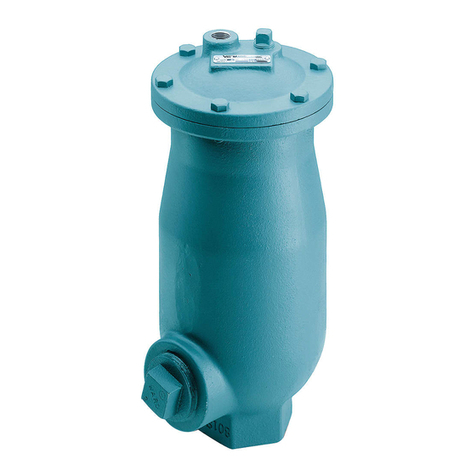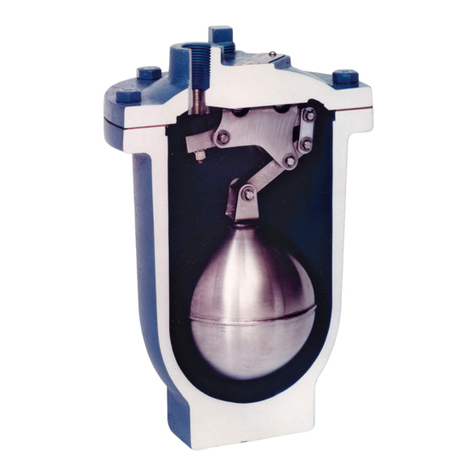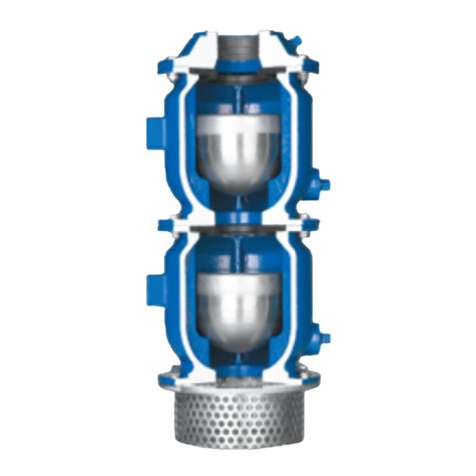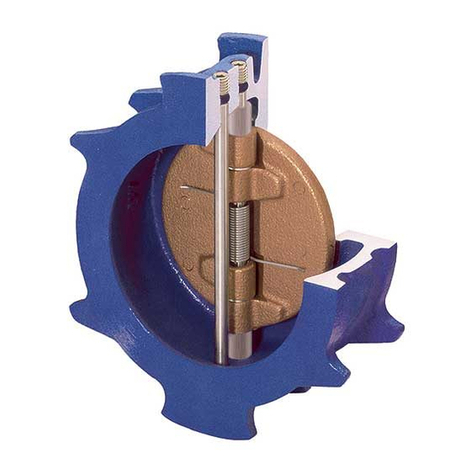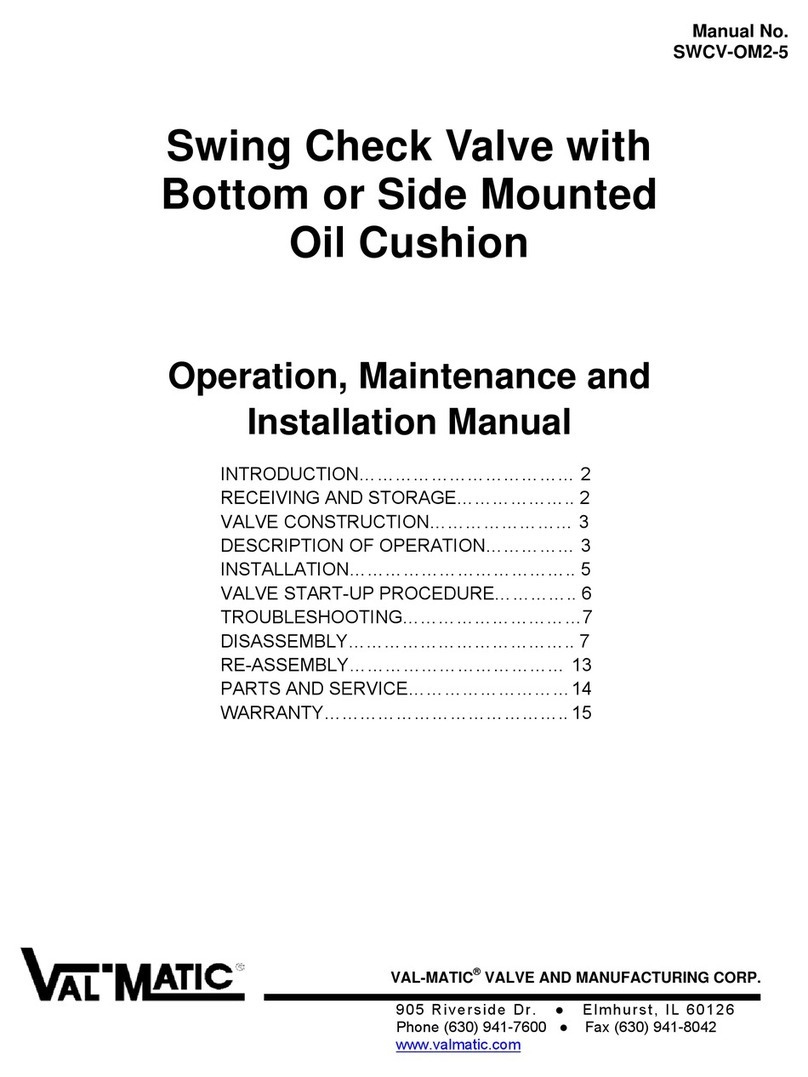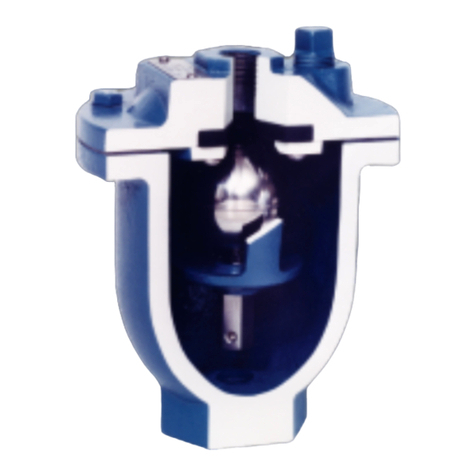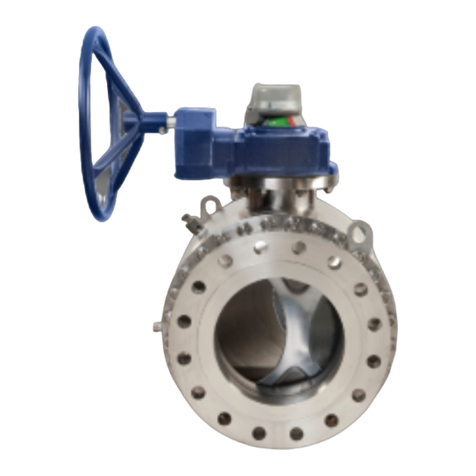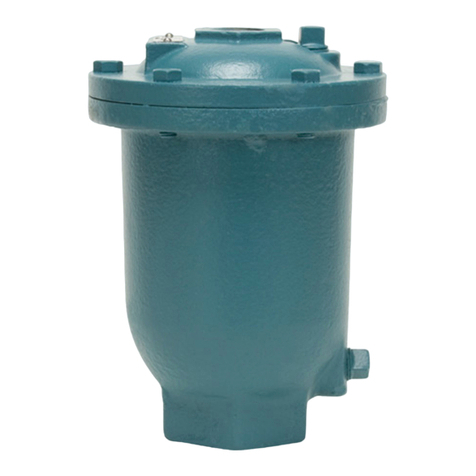
5
WARNING
Wear safety glasses to look into the valve outlet
after installation. Released fluid can cause
injury.
WARNING
The valve must be drained before removing the
cover or pressure may be released causing
injury.
Inspection: Periodic inspection to verify operation
can be performed. The valve should not leak fluid at
any connection or through the outlet. If there is
leakage through the outlet, perform a backwash
procedure on the valve. Also check to see that air is
being released by cracking open the lower drain
valve (B). If a large amount of air is released from
the drain valve, then the main valve may be clogged
and a backwash procedure should be performed.
Lubrication: The Wastewater Combination Air
Valve is a self-contained automatic valve and does
not require any lubrication to enhance its operation.
Tools: No special tools are needed to maintain or
repair the valve. The valve can be equipped with
backwash valves and hoses for ease of
backwashing.
Backwash Procedure: In order to properly
backwash the valve, a 1" clean water supply of at
least 30 psi is needed. This supply should be
connected to the rubber hose with quick disconnect
couplings as provided with the wastewater valve and
shown in Figure 5.
1. Pipe valve B to a drain prior to backwashing.
2. Close inlet valve A.
3. Open drain valve B.
4. Connect water supply to C/D and supply water
for 3 minutes to flush seat and mechanism area.
5. Additional washing of seat area can be
accomplished by placing the water supply over
the discharge into the Outlet port.
6. Close valves D and B.
7. Slowly open valve A to place back in service.
TROUBLESHOOTING
Several problems and solutions are presented below
to assist you in troubleshooting the valve assembly
in an efficient manner.
Leakage at Bottom Connection: Tighten valve
threaded connection. If leak persists, remove
valve and seal threads with Teflon* sealant or
tape.
Leakage at Cover: Tighten bolts per Table 4,
replace gasket.
Valve Leaks when Closed: Backwash valve to
remove debris. Disassemble and inspect seat,
orifice button, and float. NOTE: Many floats
contain sand for weight but if water is detected,
replace float.
Valve not Venting Air: Check that operating
pressure does not exceed Working Pressure on
nameplate. Backwash or clean valve.
DISASSEMBLY
The valve can be disassembled without removing it
from the pipeline. Or for convenience, the valve can
be removed from the line. All work on the valve
should be performed by a skilled mechanic with
proper tools. No special tools are required.
1. See Figure 3. Close inlet shut-off valve (A).
Open drain valve (B) or remove drain plug. See
Figure 5. Unscrew the Regulated Exhaust
Device from the top of the valve. Remove the
cover bolts (7) on the top cover of the air valve as
shown in Figure 2.
2. Pry cover (2) loose with sharp chisel or
screwdriver and lift off valve body. The float will
be connected to the cover.
3. Remove the retainer screws (28) and inspect the
seat (4) and button (11) for cracks in the rubber
or wear in the sealing surfaces.
4. Remove the plug (16) from the baffle (3). The
small orifice through the plug should be clean.
The plug shaft and bushing (9) ID should be
polished clean with 4x0 steel wool or 320 grit
polishing compound.
5. Turn guide bushing (9) to remove it from the
baffle. Remove the retainer rings (13) to
disassemble the float arm assembly.
6. Clean and inspect parts. Note: If floats contain
water, replace. Replace worn parts as
necessary.
REASSEMBLY
All parts must be cleaned and gasket surfaces
should be cleaned with a stiff wire brush in the
direction of the serrations or machine marks. Worn
parts, gaskets and seals should be replaced during
reassembly. Refer to Figure 2.
1. Apply Loctite 680 thread sealant to guide bushing
threads (9) and thread bushing into baffle (3).
